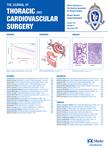版权所有:内蒙古大学图书馆 技术提供:维普资讯• 智图
内蒙古自治区呼和浩特市赛罕区大学西街235号 邮编: 010021

作者机构:Cleveland Clin Dept Thorac & Cardiovasc Surg Heart Vasc & Thorac Inst Cleveland OH 44195 USA Cleveland Clin Lerner Res Inst Quantitat Hlth Sci Cleveland OH 44195 USA
出 版 物:《JOURNAL OF THORACIC AND CARDIOVASCULAR SURGERY》 (胸腔与心血管外科学杂志)
年 卷 期:2022年第164卷第4期
页 面:1080-1087页
核心收录:
学科分类:1002[医学-临床医学] 100210[医学-外科学(含:普外、骨外、泌尿外、胸心外、神外、整形、烧伤、野战外)] 10[医学]
基 金:Judith Dion Pyle Chair in Heart Valve Research
主 题:mitral valve repair mitral valve replacement robotic surgery minimally invasive screening algorithm
摘 要:Objective: Patient selection for robotically assisted mitral valve repair remains controversial. We assessed outcomes of a conservative screening algorithm developed to select patients with degenerative mitral valve disease for robotic surgery. Methods: From January 2014 to January 2019, a screening algorithm that included transthoracic echocardiography and computed tomography scanning was rigorously applied by 3 surgeons to assess candidacy of 1000 consecutive patients with isolated degenerative mitral valve disease (age 58 +/- 11 years, 67% male) for robotic surgery. Screening results and hospital outcomes of those selected for robotic versus sternotomy approaches were compared. Results: With application of the screening algorithm, 605 patients were selected for robotic surgery. Common reasons for sternotomy (n = 395) were aortoiliac atherosclerosis (n = 74/292, 25%), femoral artery diameter 7 mm (n = 60/292, 20%), mitral annular calcification (n = 83/390, 21%), aortic regurgitation (n = 100/391, 26%), and reduced left ventricular function (n = 126/391, 32%). Mitral valve repair was accomplished in 996. Compared with sternotomy, patients undergoing robotic surgery had less new-onset atrial fibrillation (n = 144/582, 25% vs n = 125/373, 34%;P = .002), fewer red blood cell transfusions (n = 61/601, 10% vs 69/395, 17%;P .001), and shorter hospital stay (5.2 +/- 2.9 days vs 5.9 +/- 2.1 days;P .001). No hospital deaths occurred, and occurrence of postoperative stroke in the robotic (n = 3/605, 0.50%) and sternotomy (n = 4/395,1.0%;P = .3) groups was similar. Conclusions: This conservative screening algorithm qualified 60% of patients with isolated degenerative mitral valve disease for robotic surgery. Outcomes were comparable with those obtained with sternotomy, validating this as an approach to select patients for robotic mitral valve surgery.